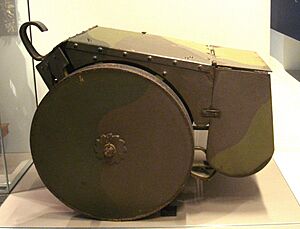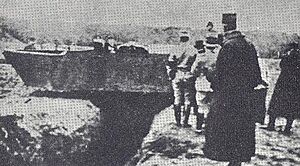Jean Baptiste Eugène Estienne facts for kids
Quick facts for kids
Jean Baptiste Eugène Estienne
|
|
|---|---|
| Born | 7 November 1860 Condé en Barrois, France |
| Died | 2 April 1936 (aged 75) Paris |
| Allegiance | France |
| Service/ |
French Army |
| Years of service | 1882–1927 |
| Rank | General of Artillery |
Jean Baptiste Eugène Estienne (born November 7, 1860, died April 2, 1936) was a French general. He was a very important person in the French army. He helped create modern French artillery and military aviation. He is most famous for creating the French tank arm. Many people in France call him the Père des Chars, which means "Father of the Tank".
Contents
Who Was Jean Estienne?
Jean Estienne was born in a place called Condé-en-Barrois, in France. When he was 19, he got into a famous military school called the École Polytechnique. He was very smart and even won a national math competition in 1882. He loved math and philosophy, but his biggest interest was ancient Greek history.
Estienne's Military Career
How Did Estienne Improve Artillery?
Jean Estienne joined the French army in 1883. He worked with artillery, which means big guns. He studied how bullets and shells fly (this is called ballistics). In 1890, he wrote an important paper about how to shoot guns more accurately. This helped the army start using modern ways to shoot without seeing the target directly, called indirect fire.
He became a Captain in 1891. He started making special tools to measure distances at the Bourges arsenal. These tools helped put his ideas into practice. Later, he worked in Paris, making precise instruments for artillery. He also pushed for using telephones to help artillery units change targets quickly.
How Did Estienne Help Military Aviation?
By 1907, Estienne was known as one of France's best and most forward-thinking officers. He was also one of the people who helped create modern artillery. In 1909, General Brun started the French aviation service. Estienne was the perfect person to lead it. Airplanes were mainly used to help direct artillery fire. So, Estienne, now a Lieutenant-Colonel, became one of the founders of French military aviation. He helped set up how the aviation service would work, how pilots would be trained, and how planes would be made. He also worked on ways for planes to communicate with soldiers on the ground.
Estienne and World War I
When First World War started, Estienne commanded an artillery regiment. His artillery was very accurate, which surprised the German army. This was because his unit worked closely with airplanes. But even with accurate artillery, French soldiers were still getting hurt by machine gun fire. To protect them, Estienne thought about creating mobile personnel shields. These would be like moving shields for soldiers.
Estienne had always believed in indirect fire. Now, he started looking for ways to give close support to soldiers using field guns. On August 23, 1914, he famously said that victory would go to the side that could put a 75mm gun on a vehicle that could move anywhere. But at that time, there were no vehicles strong enough.
In 1915, he heard that a company called Schneider was working on a machine that could cut barbed wire. It used tracks, like a tractor. Estienne wrote letters to the French army leaders. He suggested using these tracked vehicles for fighting. He thought they could help 20,000 soldiers break through enemy lines. These vehicles could also carry men, equipment, and supplies.
On December 1, 1915, Estienne wrote directly to the main commander, Joseph Joffre. He explained his idea for a force of all-terrain armored vehicles. He believed these vehicles could help soldiers break through German defenses. On December 12, he explained his ideas further to General Maurice Janin. A few days before, he had seen a demonstration of the chassis (the base) of what would become the Schneider CA1 tank. He realized that this prototype could be a strong argument for creating an armored force. He was right. On December 20, the army decided to produce the Schneider CA tank.
Estienne also tried to convince Louis Renault, a car maker, to build tanks. Renault refused at first. But on January 18, 1916, Estienne convinced the supreme commander, Joffre, that the tank plan was good.
Estienne was not directly involved in building the first tanks. But he suggested ideas. On July 16, he learned that Renault was developing a light tank, the Renault FT. On September 30, Estienne was put in charge of the Artillerie Spéciale, which was the French army's new tank arm. He was promoted on October 17.
There were not enough people or materials at first. Estienne spent many months building the new tank force from nothing. He recruited soldiers and built training grounds. The first Schneider CA tank was delivered on December 1, and training began. During this time, he worked with Renault to develop the Renault FT tank. He also tried to stop efforts to build very heavy tanks, which would have used up all the available production.
On April 16, 1917, the new commander, Robert Nivelle, made Estienne use his tanks too early. This happened near Berry-au-Bac and was a complete failure. Many tanks were lost, and the officer leading the attack was killed. This disaster almost led to the tank force being shut down. Estienne was saved because his friend Pétain became the new Commander-in-Chief.
Estienne then focused on creating the right ways to use tanks. He thought tanks should act like mobile artillery. They could move across damaged battlefields and break through enemy lines. Heavier tanks could do this, but a "swarm" of lighter, faster tanks would be more effective.
In 1918, many Renault FT tanks became available. This allowed the French army to fight back effectively for the first time since 1914. The FT tank became known as the Char de la Victoire (Victory Tank). This showed everyone that a strong tank force was very important.
After the War
After the war, in 1919, Estienne suggested that the army needed armored, tracked vehicles to carry soldiers, artillery, and repair teams alongside the tanks. He also thought airplanes should bomb enemy positions deeply. These ideas were very advanced for the time.
Estienne commanded French tank forces until 1927. In 1921, he suggested creating an army of 100,000 men with 4,000 tanks and 8,000 transport vehicles. He believed this force could break through enemy lines and advance 80 km in one night. However, the French military leaders at the time thought tanks should only support soldiers. They did not listen to his ideas.
Estienne believed that tanks should not just support infantry. He continued to argue this point until he died in 1936.
Travel Across the Sahara Desert
In May 1923, Estienne became the president of a company called the Compagnie Générale Transsaharienne. This company was formed to promote travel across the Sahara Desert by car and airplane. His sons, Georges and René, took part in several trips across the Sahara for this company.
Estienne's Legacy
Jean Estienne is honored in France as the "Father of the Tanks." A street in Paris is named after him. Several military bases also carry his name. The largest tank museum in the world, the Musée des Blindés in Saumur, France, is called "Musée Général Estienne" in his honor.
Images for kids





